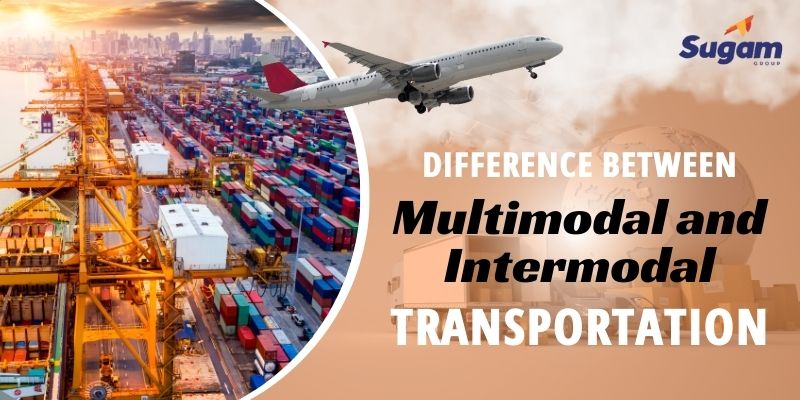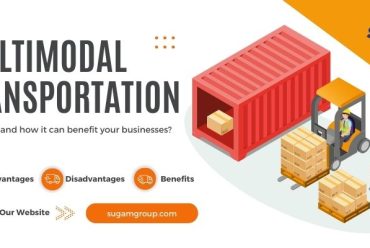Difference Between Multimodal and Intermodal Transportation
In today’s world, transportation plays a vital role in the movement of people and goods from one place to another. Multimodal and intermodal transportation are two terms that are often used interchangeably, but they are different. This blog post aims to define the two terms and explain the differences between them, highlighting the advantages and disadvantages of each type of transportation. By the end of this blog, you will have a clear understanding of the differences between multimodal and intermodal transportation and how to choose the most efficient and cost-effective mode of transportation for their needs.
What is Intermodal Transportation?
Intermodal transportation is a type of multimodal transportation that involves the use of standardized containers that can be transferred between different modes of transportation without the need for repackaging. For example, a shipment can move from the factory to the rail station using a truck, then from the rail station to the destination using a train, without the need to unpack the goods from the container.
How Intermodal Transportation works?
Intermodal transportation involves using multiple modes of transportation to move goods, typically combining rail, truck, and sea transport. The goods are transported in containers that are designed to be easily transferred between different modes of transportation. The containers are loaded onto flatbed trailers or trains and transported to their destination, with the aim of reducing transportation costs and improving efficiency.
Advantages of Intermodal Transportation
Intermodal transportation is highly efficient because it eliminates the need for multiple handling of goods, reducing the risk of damage or loss of goods. It also enables shippers to reduce transportation costs by choosing the most efficient combination of modes of transportation. Let’s explore the advantages in detail:
- Cost savings: Intermodal transportation can be more cost-effective than other modes of transportation, as it utilizes multiple modes of transportation to move goods. This can help to reduce transportation costs and increase profitability for shippers.
- Improved efficiency: Intermodal transportation is designed to optimize efficiency and reduce transit times. By utilizing the strengths of each mode of transportation, intermodal transportation can provide faster transit times than a single mode of transportation.
- Reduced congestion and pollution: Intermodal transportation can help to reduce congestion on the roads and highways, as well as reduce pollution from transportation. This is because it makes use of more environmentally-friendly modes of transportation, such as rail and water.
- Increased security: Intermodal transportation provides increased security for goods in transit, as the cargo is often sealed in containers that are difficult to access or tamper with. This can help to reduce the risk of theft or damage during transportation.
- Greater flexibility: Intermodal transportation provides greater flexibility than other modes of transportation, as it allows shippers to use multiple modes of transportation to move goods. This can help to ensure that the goods arrive at their destination on time and in good condition, even if there are unexpected delays or disruptions.
What is Multimodal Transportation?
Multimodal transportation involves the use of two or more modes of transportation to move goods from one place to another. For example, a shipment can move from the factory to the port using a truck, then from the port to the destination using a ship. In this case, two modes of transportation (road and sea) are used to transport the goods.
How Multimodal Transportation works?
Multimodal transportation is a logistics strategy that entails utilizing more than one mode of transportation to transport goods from one location to another. The goal of this approach is to enhance efficiency and reduce transportation expenses. The process involves careful planning and coordination, and the goods are transferred between different modes of transportation at different points throughout the journey.
Advantages of Multimodal Transportation:
Multimodal transportation is beneficial because it allows for greater flexibility in the transportation process. It enables shippers to choose the most efficient and cost-effective combination of modes of transportation for their needs. Let’s drive deeper into the advantages or benefits of multimodal transportation:
- Increased efficiency: Multimodal transportation allows shippers to choose the most efficient combination of modes of transportation for their needs. This can reduce transportation costs and lead to faster delivery times.
- Greater flexibility: With multimodal transportation, shippers have the flexibility to choose the best routes and modes of transportation based on their needs. This can help them avoid congested areas or routes that may be subject to delays or other issues.
- Reduced risk of damage or loss: As goods are handled less frequently in multimodal transportation, the risk of damage or loss is reduced. This can lead to lower insurance premiums and fewer claims.
- Improved environmental sustainability: Multimodal transportation can be more environmentally sustainable than other modes of transportation, as it reduces the carbon footprint associated with transportation. This is particularly true for shorter distances, where road transportation can be substituted for rail or water transportation.
- Better access to markets: Multimodal transportation can provide better access to markets that may be difficult to reach by a single mode of transportation. This can help shippers expand their customer base and increase sales.
Difference Between Multimodal and Intermodal Transportation
Two commonly used methods of transportation are multimodal and intermodal transportation, which share some similarities but have key differences. Let’s explore the differences between multimodal and intermodal transportation:
- Management: Multimodal transportation involves each mode of transportation being managed separately, whereas intermodal transportation involves the entire shipment being managed by a single entity or transportation provider.
- Coordination: Multimodal transportation requires coordination between different transportation providers and modes of transportation, while intermodal transportation coordination is handled by a single entity or transportation provider.
- Equipment: Multimodal transportation may require different types of equipment for each mode of transportation, while intermodal transportation uses standardized equipment, such as containers, that can be easily transferred between different modes of transportation.
- Cost: Multimodal transportation may involve higher costs due to the need to coordinate between different transportation providers and modes of transportation, while intermodal transportation can be more cost-effective due to standardized equipment and coordinated management.
- Flexibility: Multimodal transportation offers greater flexibility in terms of selecting specific modes of transportation for specific parts of the journey, while intermodal transportation offers less flexibility as the entire shipment is managed by a single entity or transportation provider.
Conclusion
In conclusion, multimodal and intermodal transportation are two methods that businesses can use to transport goods using multiple modes of transportation. While they share some similarities, they differ in terms of management, coordination, equipment, cost, and flexibility. Understanding the differences between the two is essential to make informed decisions on which method to use, depending on the specific needs of the shipment. Ultimately, businesses must weigh the advantages and disadvantages of each method to choose the one that best fits their needs and budget.
If you have any questions, feel free to call 1800112243 or write to us on sales@sugamgroup.com








No Comments